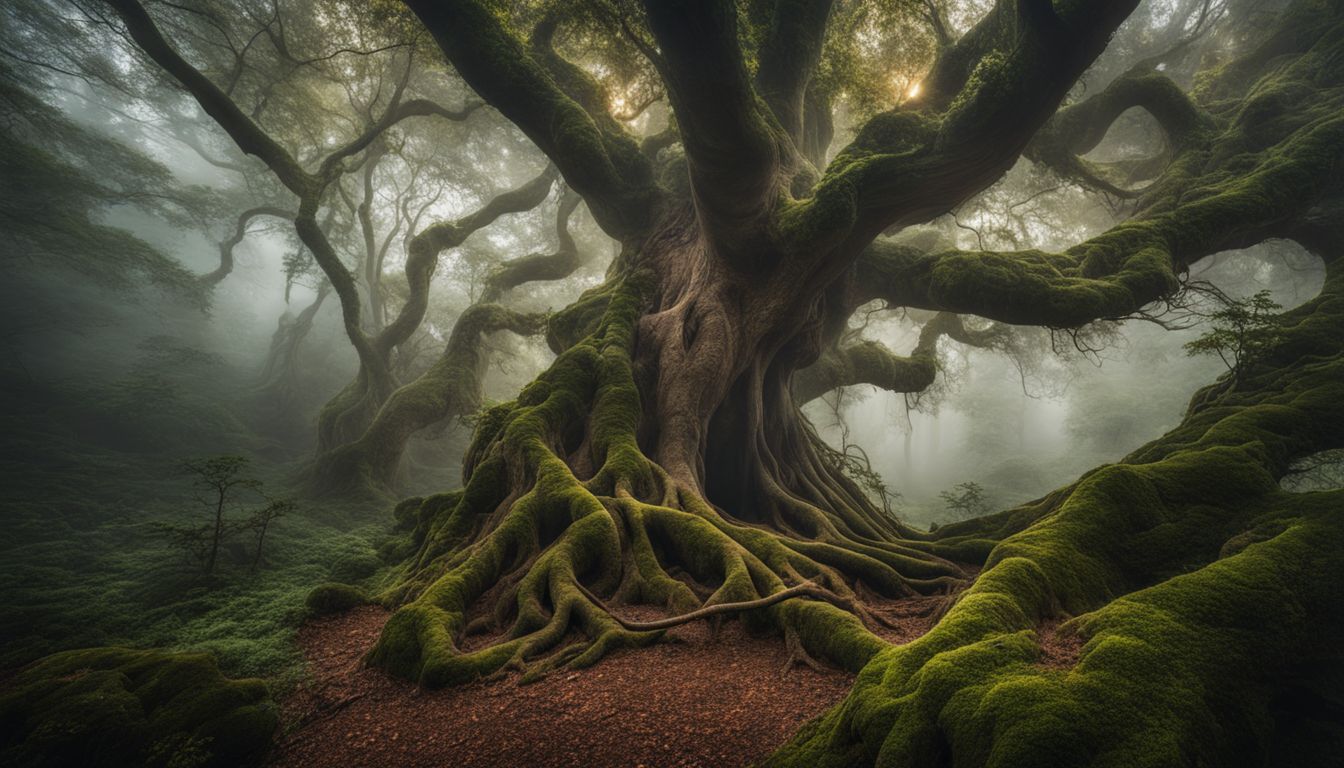Exploring the Celtic Tree of Life Symbol and its Meaning
Have you ever found yourself pondering the deeper meanings hidden within ancient symbols? I know that feeling all too well, particularly when it comes to the enchanting Celtic Tree of Life.
Diving into its rich history and symbolism, I came to understand that this isn’t just an eye-catching design; it’s a profound representation of wisdom, strength, and positivity. In this article, we’ll journey together through its fascinating background, explore various interpretations, and uncover why it continues to hold significance in our lives today.
Ready for a captivating read? Stay with me!
Key Takeaways
- The Celtic Tree of Life symbolizes wisdom, strength, interconnectedness of all life, and the cycle of birth, death, and rebirth. It reflects ancient Celts’ deep connection to nature.
- Trees played a vital role in daily Celtic life, not just for their practical uses but as sacred elements that connected the earth with the spiritual world.
- In modern times, the Tree of Life remains significant in jewelry designs. Its meanings of strength, endurance, and connection to nature appeal to many people today.
- Different cultures have their own interpretations of the Tree of Life symbol. Norse mythology’s Yggdrasil and Gaelige culture’s Crann Bethadh are examples.
- Folklore surrounding the Tree of Life includes tales about its mystical powers and heroes seeking guidance from it. These stories highlight its significance in Celtic mythology.
History and Symbolism of the Celtic Tree of Life
The Celtic Tree of Life holds deep meaning in ancient Celtic culture. It symbolizes the interconnectedness of all living things and represents strength and endurance.
Origin and meaning in Celtic culture
In Celtic culture, the tree of life carries a deep and powerful meaning. It stood for wisdom, strength, and longevity. These ancient folks saw trees as vital beings connecting the heavens and the earth.
They believed these mighty oaks held the powers of ancestors, nature spirits, and otherworldly beings. By honoring trees, they felt close to all three realms – land, sea, and sky.
Trees were more than just plants; they were symbols of life’s cycle — birth, death, and rebirth. This belief in reincarnation linked closely with their understanding of nature’s cycles.
So wearing a Celtic tree of life tattoo or carrying it on jewelry wasn’t just about beauty or fashion. It was a sign of respect for this deep spiritual connection with the environment around them.
Let’s move on to how essential trees were in daily Celtic life.
The importance of trees in daily life
Trees are essential for our daily lives. They provide us with clean air to breathe and shade to seek respite from the sun. Trees also offer a habitat for wildlife, contribute to soil health, and act as natural filters for water sources.
The trees’ importance lies in their ability to sustain life on earth by producing oxygen through photosynthesis and absorbing carbon dioxide, thereby reducing the impact of climate change.
In addition, trees hold cultural significance and serve as a source of inspiration in art and literature. Moreover, they provide raw materials such as wood for construction, paper products, and essential oils used in various industries.
Spiritual significance
Moving from the importance of trees in daily life to the spiritual significance, it’s fascinating to explore how the Celtic Tree of Life holds deep meaning. In Celtic culture, this symbol represents a connection between all living things and the afterlife.
It’s also associated with wisdom, strength, and renewal, reflecting the cyclical nature of life. The Celts believed that trees held sacred knowledge and were a link between the upper and lower worlds.
This symbol is not just an artistic representation but a powerful reflection of their spirituality.
Symbol of strength and endurance
The Celtic Tree of Life symbol is not only a representation of spiritual significance but also a powerful symbol of strength and endurance. This enduring symbol reflects the resilience and longevity associated with the oak tree, embodying characteristics like wisdom, durability, protection, and knowledge.
It signifies the ability to withstand challenges and persevere through tough times, serving as a reminder of inner strength and fortitude in the face of adversity. The Tree of Life stands tall as a timeless emblem that continues to inspire travelers with its profound message of endurance amidst life’s trials.
Continuing from the symbolism topic above into other related themes..
Design and Variations of the Celtic Tree of Life
The Celtic Tree of Life symbol has a recognizable design that holds various interpretations in different cultures, inviting readers to discover its rich meanings and cultural significance.
The recognizable design
The Celtic Tree of Life symbol features a distinctive design with interlacing branches and roots, symbolizing the interconnectedness of all life. This recognizable motif often incorporates knots, circles, and spirals within its structure.
The intricate patterns are meant to represent the continuous cycle of life, death, and rebirth. The symbol’s distinct visual elements convey the idea of eternity and unity among all living beings in nature.
Its unique design offers a captivating glimpse into the deep spiritual beliefs held by the Celts, emphasizing harmony with the natural world.
The design variations of the Celtic Tree of Life hold significant meaning and symbolism across different cultures. The tree’s image has been adapted in various ways to express diverse interpretations associated with spirituality, renewal, and interconnectedness in different societies around the globe.
Different interpretations in other cultures
The Celtic Tree of Life symbol holds different meanings in various cultures. In Norse mythology, the Yggdrasil is a sacred tree that connects the nine worlds and is commonly associated with the Tree of Life symbolism.
Also, in Gaelige culture, the Crann Bethadh represents interconnectedness and balance within nature. These interpretations highlight the universal significance of the Tree of Life across cultures.
Moving over to “The Legend Behind the Tree of Life”..
Various meanings associated with the symbol
The Celtic Tree of Life holds a multitude of meanings, including strength, wisdom, and the interconnectedness of all beings. It is also seen as a representation of balance and harmony in nature, symbolizing longevity, rebirth, and the cyclical nature of life.
Additionally, the symbol is associated with protection and endurance along with the concept of reincarnation. The rich history and deep-rooted significance make it a treasured emblem that resonates across cultures.
—
The Legend Behind the Tree of Life
The legend of the Tree of Life is deeply rooted in Celtic mythology, with tales of its mystical powers and significance in shaping the world. The symbolism behind the tree holds a rich heritage that continues to captivate and inspire people across cultures.
Tales and mythology surrounding the Tree of Life
The ancient Celtic tales and mythology surrounding the Tree of Life are fascinating. The Celts believed that the tree was a doorway to the spirit world, connecting the earth and the heavens.
It symbolized growth, strength, and the cycle of life. The legends spoke of magical beings guarding this sacred tree, protecting its wisdom and power from those who sought to misuse it.
In Gaelic tradition, it was believed that touching or even being near a certain kind of sacred oak could bring about profound knowledge and visions. Furthermore, there were stories about heroes seeking out this mystical tree for guidance during their quests for truth and enlightenment.
Interpretations of its symbolism
The Celtic Tree of Life holds various interpretations and meanings. It is revered as a symbol of strength, endurance, and wisdom in the Celtic culture. Additionally, it embodies the concept of balance and harmony in nature, representing longevity, rebirth, and the cyclical nature of life.
The Tree of Life also symbolizes protection and knowledge while signifying the three stages of life: birth, death, and reincarnation. Its enduring significance continues to fascinate modern jewelry designs and tattoos.
Tree of Life Jewelry and Modern-Day Significance
Tree of Life jewelry holds deep symbolism and remains a popular choice in modern designs. Its significance resonates with many today, reflecting strength, connection to nature, and the enduring Celtic spirit.
Popular styles of Celtic Tree of Life jewelry
When it comes to Celtic Tree of Life jewelry, it holds deep symbolism and significance. It is not merely an accessory but a representation of ancient beliefs and spirituality. Let’s delve into the popular styles of Celtic Tree of Life jewelry:
- Pendants: These often feature intricate designs of the Tree of Life symbol, representing interconnectedness and harmony.
- Bracelets: Often adorned with tree-inspired patterns, symbolizing strength and endurance in life’s journey.
- Earrings: Reflecting the enduring nature of the symbol, these earrings are crafted with delicate yet enduring designs.
- Rings: Adorned with the Tree of Life motif, these rings symbolize eternal love and connectedness with nature.
- Brooches: Featuring detailed depictions of the Tree of Life, these brooches symbolize protection and wisdom.
- Amulets: Intricately designed to represent spirituality and protection, amulets are often adorned with the Tree of Life motif.
- Engraved Jewelry: Pieces bearing inspirational Celtic quotes along with the Tree of Life emblem for a personalized touch.
Celtic Tree of Life jewelry embodies timeless connections to nature and deep-rooted spiritual beliefs; each piece intertwines symbolism with modern aesthetics.
Significance and popularity in modern jewelry designs
The Celtic Tree of Life symbol holds deep significance in modern jewelry designs. Its enduring symbolism of strength, wisdom, and rebirth continues to captivate jewelry enthusiasts.
The intricate and timeless design of the Tree of Life is embraced in various styles, from pendants to bracelets, reflecting its enduring popularity. As travelers explore modern jewelry offerings, they may find that the Celtic Tree of Life symbol resonates with the desire for connection to nature and spiritual elements.
– Conclusion
Conclusion
Exploring the Celtic Tree of Life symbol opens up a fascinating journey into ancient cultures and their connection to nature. This emblem, rich with attributes like wisdom, strength, and positivity, offers more than just artistic beauty; it provides deep insights into Celtic spirituality and beliefs.
Through its various representations, from tattoos to jewelry designs today, the Tree of Life maintains an important place in both historical context and contemporary relevance.
Trees were crucial to the Celts for their survival but also held profound spiritual significance. They symbolized balance, harmony in nature, rebirth, longevity, knowledge – serving not only as signs of enduring strength but also as essential participants in everyday life.
The design variations across different cultures further enrich our understanding of this symbol’s widespread appeal and enduring legacy.
Interpreting the legend behind the Tree of Life adds another layer to its mystery. Tales woven around this tree bring to light interpretations about life cycles—birth, death reincarnation—echoing universal truths across time periods.
Modern-day appreciation reflects through popular styles of Celtic Tree of Life jewelry that carry forward its legacy. These pieces embody meanings ranging from personal growth to interconnectedness with the natural world—a testment to how these ancient symbols continue influencing current trends.
With each piece influenced by stories from past ages and admired for endless reasons by wearers today—the fascination with exploring meaning behind the Celtic Tree of Life proves timeless.







